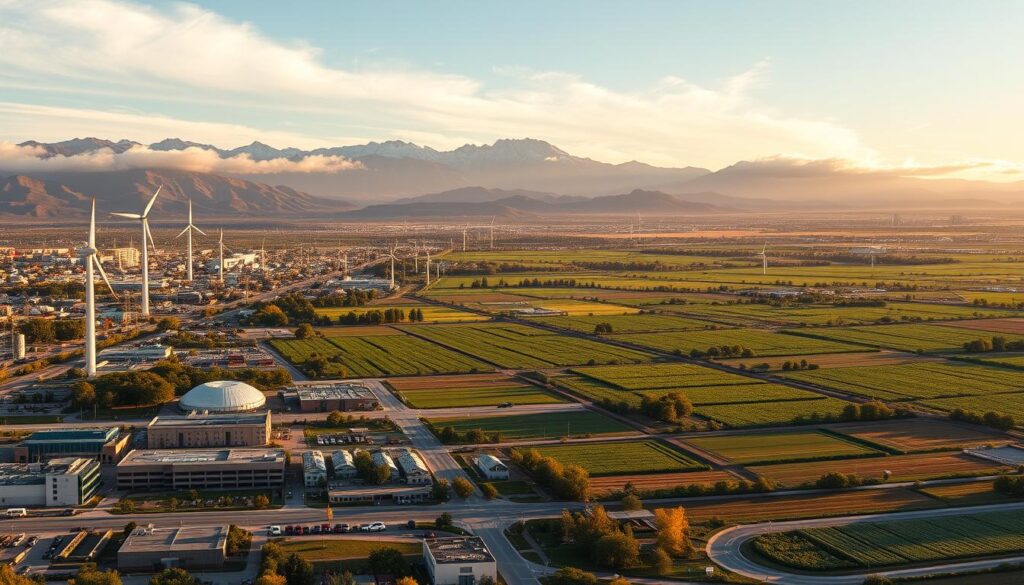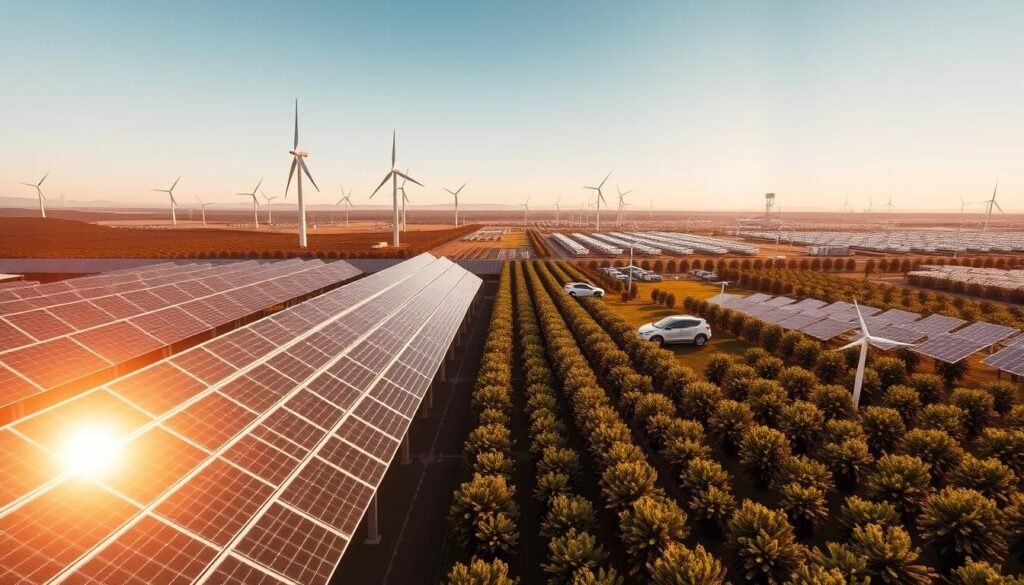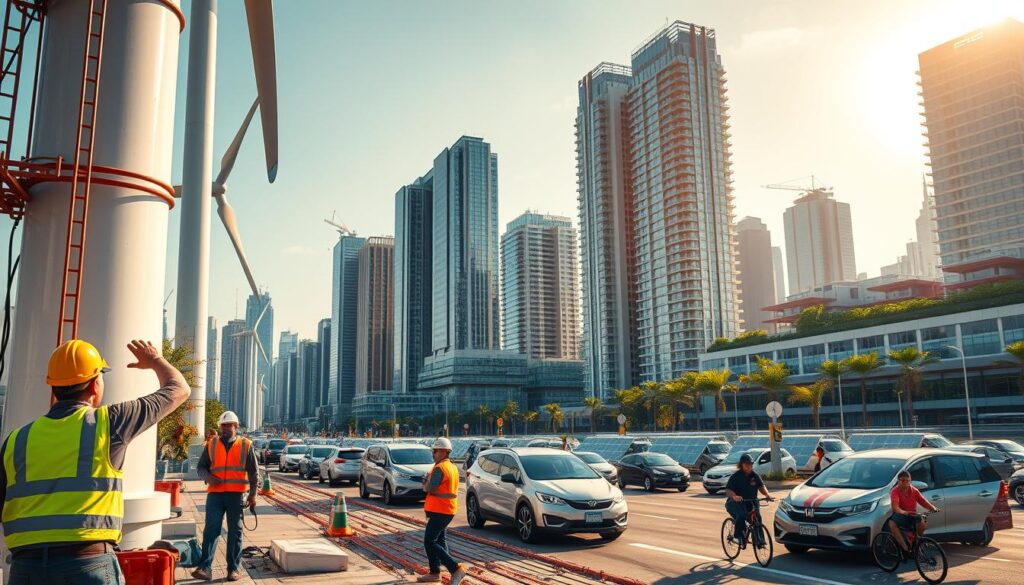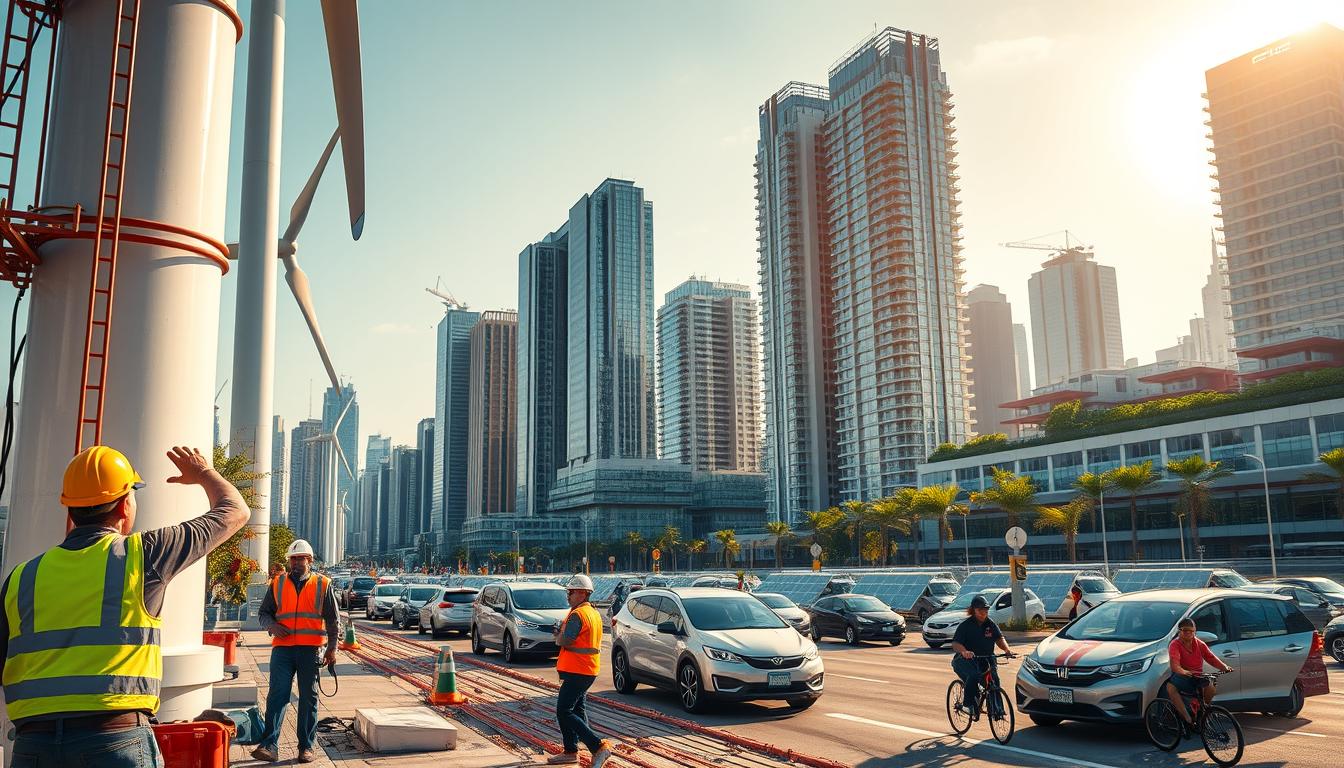The United States is at a critical juncture in its economic growth. Climate resilience is key to its future. It’s vital to balance economic growth with environmental protection for long-term prosperity.
Climate resilience is not just an environmental issue. It’s also an economic one. The economic impacts of climate change are far-reaching. Investing in climate resilience can reduce these risks and promote growth.

As the country moves forward, prioritizing climate resilience is crucial. This will help create a prosperous and sustainable future. Adopting a proactive approach to climate change is essential for achieving this goal.
Introduction to Climate Resilience
Climate resilience is complex and multifaceted. It requires a comprehensive approach to address its various aspects. Ensuring the economy can withstand climate-related disasters is essential for sustainable growth.
Key Takeaways
- Prioritizing climate resilience is essential for the long-term prosperity of the U.S. economy
- A sustainable economy balances economic growth with environmental protection
- Climate resilience is critical for reducing economic risks associated with climate change
- Investing in climate resilience can promote economic growth and development
- A comprehensive approach is necessary to address the challenges posed by climate change
- Climate resilience, sustainable economy, and economic growth are interconnected and essential for a prosperous future
Understanding Climate Resilience in U.S. Economy
The U.S. economy is facing big challenges because of climate change. It’s causing rising temperatures, sea-level rise, and extreme weather. This makes the country more vulnerable to disasters.
To fight these effects, we need to understand economic climate resilience. It’s about making the economy strong against climate shocks. This means using strategies like renewable energy, better infrastructure, and sustainable practices.
Some key factors that make the U.S. vulnerable to climate change include:
- Rising temperatures, which can lead to heatwaves and droughts
- Sea-level rise, which can cause coastal flooding and erosion
- Extreme weather events, such as hurricanes and wildfires
These factors can hurt the economy a lot. They can damage buildings, reduce work, and increase healthcare costs. So, it’s vital to boost economic resilience and lower climate vulnerability. This will help the U.S. economy stay strong and prosperous.
The Economic Cost of Climate Inaction
The economic cost of not acting on climate change is a big worry for the United States. If we don’t tackle climate change, we face serious problems. These include damage to buildings, lost work hours, and higher healthcare bills. Sustainable development is key to avoiding these issues and keeping our economy strong.
Some major economic impacts of climate change are:
- Destruction of property and infrastructure due to extreme weather events
- Loss of productivity in industries such as agriculture and construction
- Increased healthcare costs due to heat-related illnesses and other climate-related health issues
To lessen the economic harm of climate inaction, we need to invest in climate resilience. This means using renewable energy, building green infrastructure, and making buildings more climate-friendly. By acting early, the United States can avoid big economic losses and secure a bright future.
There are many advantages to sustainable development and climate resilience. They help cut down the economic damage of climate inaction. They also create jobs, boost the economy, and make people healthier. By focusing on sustainable development and climate resilience, the United States can create a better economy for all.
Key Sectors Requiring Climate Adaptation
The United States faces big challenges from climate change. We need to focus on key sectors that must adapt. These sectors are vital to our economy and help us thrive in a changing world.
Using green technologies is key to reducing climate change risks. Renewable energy like solar and wind power cuts down on harmful emissions. This helps us move towards a greener future.
By investing in climate adaptation, we can lower the economic costs of climate change. It also opens up new chances for growth and progress.
- Agriculture and food security, which are vulnerable to changes in temperature and precipitation patterns
- Infrastructure and construction, which must be designed and built to withstand more frequent and intense natural disasters
- Energy systems, which must be transformed to rely on renewable energy sources and reduce dependence on fossil fuels
- Financial services, which must develop new products and services to help individuals and businesses manage climate-related risks
By focusing on climate adaptation, the United States can become less vulnerable to climate change. This makes our economy more sustainable and resilient. Green technologies, like renewable energy, are crucial for this transition. They ensure a bright future for all of us.
Federal Policy Initiatives for Climate Resilience
The U.S. government has launched many policy initiatives to help with climate resilience and growth. These efforts aim to cut down on greenhouse gas emissions and lessen climate change’s effects. It’s vital for the government to work together to tackle climate change effectively.
Some major policies include investing in clean energy, making energy use more efficient, and supporting green land use. These actions help with climate efforts and push for sustainable growth. The government also has programs for climate-ready infrastructure, smart farming, and making informed decisions.
Key aspects of federal policy initiatives for climate resilience include:
- Developing and implementing climate-resilient infrastructure
- Promoting climate-smart agriculture and forestry practices
- Supporting climate-informed decision-making and planning
- Encouraging sustainable growth and reducing greenhouse gas emissions
Federal policy for climate resilience is key for sustainable growth and fighting climate change risks. By backing climate-ready infrastructure, smart farming, and informed decisions, the government can lessen climate change’s effects. This helps pave the way for a greener future.
Private Sector Leadership in Climate Adaptation
The world faces big challenges from climate change. But, the private sector is stepping up to help. Companies are now using corporate climate strategies to cut down on their environmental harm. They’re also making investments that last for the long term.
By going green, like using renewable energy and reducing waste, businesses can fight climate change. They also see benefits for their own success. This is a win-win for everyone.
Private sector leadership can really make a difference in several ways:
- Investing in resilient technologies, such as sea walls and green roofs, to protect against extreme weather events
- Optimizing supply chains to reduce carbon footprint and promote sustainable sourcing practices
- Developing innovative products and services that support climate adaptation and resilience
By leading on climate adaptation, private sector leaders can help build a better future.
Through sustainable investments and private sector leadership, we can move towards a low-carbon economy. Together, we can make a future that’s good for all generations.
Innovation and Green Technology Solutions
The world faces big challenges from climate change. Innovation is key to solving these problems. Companies like Tesla and Google are leading with green technologies. They focus on renewable energy and making things more energy-efficient.
Using green technologies helps a lot. For instance, solar and wind power cut down on fossil fuel use. This lowers emissions. Also, buildings and homes that use less energy save money and help the planet. Some important green technologies are:
- Renameable energy sources like solar and wind power
- Energy-efficient buildings and homes
- Green transportation systems

Investing in innovation and green technologies is crucial. It helps the United States become more resilient to climate change. As the country moves towards a sustainable economy, green technologies will be vital.
Building Resilient Infrastructure
The United States is facing big challenges from climate change. We need to build strong infrastructure to tackle these issues. This means creating green transportation, updating energy grids, and managing water better. Investing in strong infrastructure helps us avoid disasters and builds a better future.
Strong infrastructure is key for our economy, health, and the environment. Sustainable transportation like electric cars and green buildings cuts down on pollution. Also, updating energy grids and using smart technologies helps distribute energy better and prevents blackouts.
- Implementing green building practices and materials
- Investing in renewable energy sources and energy storage technologies
- Developing sustainable transportation systems, such as public transit and non-motorized transportation options
By focusing on resilient infrastructure, we can ensure a strong future for all. This will take teamwork and money from both sides. But the rewards will be huge.
Financial Markets and Climate Risk Assessment
Financial markets are now seeing the big deal about climate risk assessment. As we move towards a greener economy, they’re key in supporting sustainable finance. It’s vital for investors to grasp how climate change might affect their money and make smart choices.
The link between financial markets and climate risk is intricate. Climate change can hurt markets in many ways, like damaging buildings, changing how people shop, and raising regulatory hurdles. To tackle these issues, banks and other financial groups are creating new ways to gauge climate risk. These include climate stress tests, scenario planning, and climate risk models.
Here are some main ways to handle climate risk in finance:
- Mixing up investments to lessen climate risk
- Adding climate risk into investment choices and risk handling
- Building climate-ready infrastructure and tech
- Backing efforts to fight and adapt to climate change
Financial markets are essential in pushing for green finance and cutting climate risk. By factoring climate risk into their decisions, financial bodies can help build a more sustainable and strong economy.
Job Creation in the Climate-Resilient Economy
The shift to a climate-resilient economy will open up many job opportunities. As more green jobs become available, it’s key to support workforce development. This will help people gain the skills needed for these new roles. It’s a step towards fighting climate change and boosting the country’s growth.
Some key sectors for job creation in this new economy are:
- Renewable energy sector
- Sustainable infrastructure development
- Energy efficiency and conservation
- Climate-resilient agriculture and forestry
It’s vital to invest in workforce development to prepare for these green jobs. Training programs, education, and apprenticeships are essential. They should focus on skills like solar panel installation and sustainable construction. By focusing on job creation and workforce development, we can smoothly transition to a sustainable future.

Regional Economic Adaptation Strategies
The United States is working hard to tackle climate change. Regional economic adaptation is key to building resilience and sustainability. Each area has its own set of challenges and chances, needing specific plans to adapt. For instance, coastal economies face threats from rising sea levels and severe weather. Meanwhile, the agricultural heartland must adjust to changes in rain and temperature.
Some important strategies for regional economic adaptation include:
- Diversifying industries to reduce dependence on climate-sensitive sectors
- Investing in climate-resilient infrastructure, such as sea walls and green roofs
- Developing early warning systems for extreme weather events
- Implementing sustainable agricultural practices, such as crop rotation and conservation tillage
By using these strategies, areas can lessen their risk from climate change. This helps in boosting economic growth and development. For example, the agricultural heartland can use conservation tillage and crop rotation to protect soil. On the other hand, coastal economies can build sea walls and green infrastructure to fight off storm surges and floods.
International Cooperation and Trade Implications
As the world faces climate change, international cooperation is key. The trade implications of climate change are wide-ranging. It’s vital to think about how climate policies affect global trade. Global climate governance efforts, like the Paris Agreement, help nations work together to fight climate change.
The role of international cooperation is huge, as climate change is a worldwide problem. By teaming up, countries can share knowledge and resources. This helps in finding effective ways to tackle climate change. The trade implications of climate change are big, and we must consider how climate policies affect trade. For instance, tariffs and trade deals can push for climate-friendly tech and practices.
- Developing and sharing climate-resilient technologies
- Implementing climate-friendly trade policies
- Providing climate finance and support to vulnerable countries
Together, countries can tackle the trade implications of climate change. This promotes a sustainable and fair global economy. Good global climate governance is essential. It needs the effort and cooperation of all nations.
Conclusion: Forging a Sustainable Economic Future
Building a climate-resilient U.S. economy is key for long-term sustainable economic growth. We can face climate change risks and impacts head-on. This opens up new chances for innovation, job creation, and a better future for everyone.
We need a team effort from the government, private sector, and citizens. Federal policies, corporate climate plans, and green tech must all work together. This will make our nation more climate resilient.
By investing in strong infrastructure, updating energy systems, and improving supply chains, we can build a more stable economy. This will help us face climate change challenges better.
Creating a sustainable economic future is vital for our planet and our economy. As we tackle climate change, we can unlock a future that grows the economy, promotes fairness, and protects our future generations.
FAQ
What is economic climate resilience?
Economic climate resilience is when the U.S. economy can handle climate change. This includes rising temperatures, sea-level rise, and extreme weather. It’s about being able to adapt and bounce back.
What are the current challenges the U.S. faces in terms of climate vulnerability?
The U.S. is dealing with many climate-related issues. These include damage to buildings, supply chain disruptions, and threats to food production. Each region and sector has its own challenges, needing a broad approach to adapt.
What are the economic implications of climate change?
Climate change can cost a lot, like disaster response and lost productivity. It also disrupts trade and commerce. These effects can hurt businesses, consumers, and government finances.
How can the agriculture and food security sector adapt to climate change?
The agriculture and food sector can adapt by diversifying crops and managing water. Using climate-smart practices is also key. Investing in research and improving infrastructure can make the sector more resilient.
What role can the private sector play in promoting climate resilience?
The private sector is crucial in promoting climate resilience. They can use climate strategies, invest in green tech, and optimize supply chains. Companies can also reduce carbon emissions and support renewable energy.
What are some key federal policy initiatives for climate resilience?
The federal government has many policies to support climate resilience. These include laws to cut emissions, investments in green infrastructure, and research funding. These efforts aim to reduce risks and support a sustainable future.
How can financial markets and risk assessment help address climate change?
Financial markets and risk assessment are vital in tackling climate change. They help identify and manage climate risks. This includes developing tools for assessing climate risk and promoting sustainable finance.
What are the job creation opportunities in the climate-resilient economy?
Moving to a climate-resilient economy opens up new job opportunities. Jobs will emerge in green industries like renewable energy and sustainable transport. Training programs can prepare workers for these new roles.
